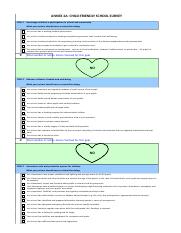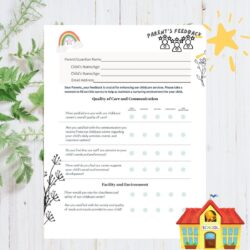Building a strong partnership between home and school is absolutely essential for a child’s educational journey. As teachers, we pour our hearts into creating a nurturing and effective learning environment, but sometimes, the most valuable insights come from those who know our students best outside the classroom – their parents. Gathering feedback from families can unlock a deeper understanding of student needs, family dynamics, and even the effectiveness of our own communication strategies.
That’s where a well-designed parent survey template for teachers comes into play. It’s not just about collecting data; it’s about opening a two-way street for conversation, showing families that their opinions are valued, and continuously refining our approach to education. Imagine gaining insights that could transform your classroom communication or tailor your teaching methods to better suit the diverse needs of your students. It’s truly a powerful tool for fostering a collaborative educational experience.
Why Parent Feedback is a Cornerstone of Educational Success
Engaging parents effectively is more than a nice-to-have; it’s a critical component of a student’s holistic development and academic achievement. When parents feel heard and respected, they become more invested partners in their child’s education, creating a seamless support system between home and school. A structured survey provides an invaluable channel for this engagement, allowing parents to share their perspectives on various aspects of their child’s school experience, from academic progress to social-emotional well-being.
Beyond individual student support, parent feedback offers a panoramic view of your classroom and even the broader school environment. It can highlight areas where communication might be falling short, reveal concerns about homework load, or even shine a light on aspects of your teaching that parents particularly appreciate. This constructive feedback empowers you to make informed decisions and adjustments, leading to a more effective and responsive educational setting for everyone involved.
Furthermore, actively seeking parent input fosters a sense of community and mutual respect. It demonstrates that you, as an educator, are approachable, open to improvement, and genuinely care about their child’s experience. This proactive approach can prevent minor issues from escalating and instead build a foundation of trust that benefits both the student and the entire classroom dynamic. When parents feel like true partners, they are more likely to support school initiatives and reinforce learning at home.
So, what specific insights can you glean from a comprehensive parent survey? The possibilities are vast, covering everything from daily routines to long-term goals. Understanding these areas will help you create a more tailored and effective learning experience for each child.
Key Areas to Explore in Your Survey
- Communication Preferences: How do parents prefer to receive updates (email, phone, app, in-person)? How often do they wish to hear from you?
- Student Well-being: Concerns about social interactions, emotional development, or any anxieties related to school.
- Academic Support at Home: How much time do they dedicate to homework help? What resources would support them?
- Classroom Environment: Any observations about the classroom’s atmosphere, discipline, or teaching style from their child’s perspective.
- Parental Involvement: Their availability and interest in volunteering, attending events, or participating in school activities.
- General Feedback and Suggestions: An open-ended section for any unaddressed thoughts or ideas they might have.
Crafting and Utilizing Your Effective Parent Survey
Designing an effective parent survey involves more than just listing questions; it requires thoughtful consideration of purpose, clarity, and ease of completion. Start by defining what you hope to achieve with the survey. Are you looking for feedback on a specific program, general communication, or student well-being? Having clear objectives will help you formulate targeted questions that yield actionable insights. Remember, the goal is to gather information that will genuinely help you improve your teaching and classroom environment.
When writing your questions, aim for a mix of question types. Likert scale questions (e.g., “On a scale of 1-5, how satisfied are you with our communication?”) are great for quantifiable data and identifying trends. Open-ended questions, on the other hand, provide rich, qualitative insights and allow parents to express nuances that a simple scale cannot capture. Ensure your language is clear, concise, and free of educational jargon. Keep the survey reasonably short to encourage completion, respecting parents’ busy schedules.
Consider the logistics of distribution and anonymity. Offering both paper and digital options (like Google Forms or SurveyMonkey) can maximize participation. It’s crucial to emphasize that responses will be kept confidential or anonymous, as this encourages more honest and open feedback. Parents need to feel safe sharing their true opinions without fear of repercussions for their child or themselves. Clearly state how the data will be used and who will have access to it.
Once you’ve collected the responses, the real work begins: analysis and action. Don’t let the valuable insights sit unused! Look for patterns, recurring themes, and actionable suggestions. Share a summary of the findings (without revealing individual identities) with parents to show them that their input was valued and listened to. Most importantly, identify concrete steps you can take based on the feedback. Even small changes, like adjusting your communication schedule or offering a new resource, can make a significant difference in building stronger home-school connections and enhancing the educational experience for all students.
A successful school year is built on a foundation of open communication and mutual understanding between educators and families. By proactively seeking out parental insights, teachers can gain invaluable perspectives that empower them to refine their teaching strategies, enhance classroom dynamics, and ultimately foster a more supportive and enriching learning environment for every child.
Embracing the feedback shared by parents is a continuous journey of growth and improvement. It’s an investment in stronger relationships, more effective teaching, and ultimately, greater student success. So, take that step, launch your survey, and watch as these valuable insights help you cultivate an even more vibrant and responsive classroom community.



